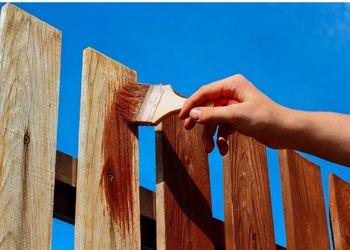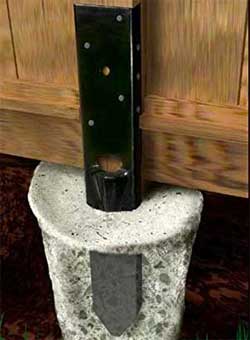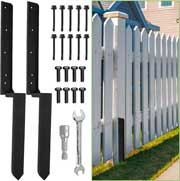1. How Much Does it Cost to Replace a Wood Fence?
Fence replacement cost varies depending on materials used, heigh of fence, labor and upgraded features. That said, the average costs currently runs between $8 and $20 per linear foot for a 6-foot tall privacy fence.

To lower your material costs, use pressure-treated pine or recycles wood from old fences or pallets. In addition, purchasing in bulk can save you money, and don’t forget to price shop different suppliers. Furthermore, go with a basic fence design and do the work yourself rather than hiring a contractor.
Also consider different fence post repair options. You may be able to extend the life of your current fence by many years and save a bunch of money (and time) in the process.
2. How Long Does it Take to Replace a Fence?
The time required to replace a fence hinges on your project’s specifics and the workforce involved. Typically, with two workers, a 100-foot wood fence might take 1 to 2 days.
For instance, this translates to around 50 feet of basic fencing when handled by a two-person team. Factors like project complexity and team size impact the timeframe for fence replacement.
If your fence is in decent shape but your have leaning fence posts, keep in mind that you may be able to fix a leaning fence in a matter of hours with support brackets like the EZ Mender or Post Buddy.
3. Should I Repair My Fence or Replace it?
Repairing a fence can save you tons of time and money. That said, it may be time for a brand new fence. Here are some factors to consider:
- If your entire fence is in bad shape, you may be better off replacing it. First, check for rotting wood or a sagging, uneven line. If it looks awful or is non-functional, it’s time to replace it.
- You may be able to get away with minor fence repairs if you simply have loose or leaning posts. For instance, if the fence planks are still in good shape, you can stain or paint the wood and add post support braces for a newer looking fence that’s fully functional.
- If you have missing or damaged boards, sometimes you can just replace those planks, especially if the fence frame is still sturdy and functional.
4. Are There Local Regulations and Restrictions for Fence Building?
Check with your homeowner’s association and/or your city or county to find out height, material or design rules for fencing.
- Maximum height restrictions
- Building codes for things like materials, construction techniques and safety features
- Setback rules regarding property lines, sidewalks or roads
- Style restrictions in community developments
- Permit Requirements
5. What Materials Do You Need to Replace a Wood Fence?
To replace a wood fence, gather wood planks, metal or wood posts, concrete mix, and hardware such as brackets, screws, nails, and hinges. Utilize tools like a post hole digger, electric drill, saw, hammer, and level.
Extend the wood’s lifespan and enhance appearance with paint or stain. These materials and tools are crucial for a sturdy and appealing fence.
6. Can I Fix a Fence Myself Or Should I Hire a Pro?
If you possess construction know-how, understand building codes, and grasp local regulations, tackling a fence project yourself is feasible.
Yet, opting for a professional might be wise, especially for complex builds, to save time and labor. Consider your skills and project complexity when deciding between DIY or hiring a pro for your fence constructio
7. How Should I Choose a Fence Contractor?
I recommend taking several specific actions when looking to hire a professional to build or repair your fence. These steps ensure that you select a qualified contractor who can deliver quality workmanship and reliable service.
- Verify License and Insurance: Always check that the contractor is properly licensed to perform construction work in your area. This not only ensures compliance with local laws but also verifies their legitimacy and professionalism. Additionally, confirm that they have liability and workers’ compensation insurance to protect against any potential accidents or damage during the project.
- Assess Experience and Expertise: Choose a contractor who has specific experience with the type of fence project you are undertaking. Ask to see a portfolio of their previous work, and check whether they have expertise in your chosen materials and design. For instance, building a vinyl fence requires different skills than constructing a wrought iron or wooden fence.
- Check Reputation: Read online reviews and ask for references from past clients. This will give you insights into the contractor’s reliability, quality of work, and customer service. Pay attention to how they handled any problems and their level of follow-through.
- Communication and Responsiveness: Ensure the contractor is easy to communicate with and responsive to your inquiries. Initial interactions can be telling; if they are prompt and clear in their communications from the start, this is a positive sign of their professionalism and customer service approach.
- Compare Prices: Obtain quotes from several contractors to compare prices. Be wary of quotes that are significantly lower than others, as this might indicate lower quality materials or cutting corners in labor. The best choice isn’t always the cheapest one; consider all factors, including materials, labor, and the contractor’s track record.
- Inquire About Warranty: Ask about the warranty on the work performed. A reputable contractor will guarantee their work and the materials used. A typical warranty might cover defects in craftsmanship or materials for a certain period. This provides you with protection and peace of mind post-installation.
8. Fence Care Tips that Can Prevent Costly Repairs

A well-maintained fence can mean fewer repairs over time. As we discussed above, painting, staining or sealing the wood can extend it’s lifespan because it protects the wood from rot and moisture. Not to mention, this simple step upgrades the look of your fence as well.
In addition, keep your fence clean by removing dirt at the base and trimming away nearby vegetation. This helps prevent moisture buildup, rotting, etc..
Lastly, make small repairs as needed before they turn into bigger more expensive problems. For example, replace broken planks or add brackets to support leaning fence posts. I hope you’ve gotten lots of ideas on how to fix a fence and ways to save money. Have fun!
Summary:
In conclusion, the decision to repair or replace a wood fence hinges on several factors including the condition of the fence, cost considerations, and personal capability to undertake such projects. I recommend regular inspections and maintenance to extend the lifespan of your fence and prevent costly repairs down the line.
Utilizing quality materials like pressure-treated pine, and employing preventive treatments such as painting or staining are crucial for protecting the fence from environmental damage. For those contemplating DIY repairs, ensure you have a solid understanding of construction techniques and local regulations.
However, for more complex or large-scale projects, hiring a professional might be the best route to ensure quality and efficiency. Ultimately, whether you choose to repair or replace, taking proactive steps will keep your fence looking great and functioning well for years to come.
Last Updated May 4, 2024


